Check out our range of stock.
Didn't find what you like?
Send us a message
Found something out of stock?
Send us a message
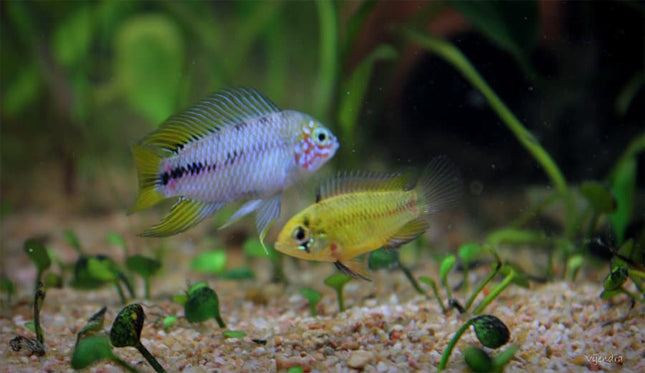
The Apistogramma borelli is a vibrant, colorful fish that comes from the Apistogramma family. This fish is native to various areas of South America and is an easy fish to take care of. It has a long, narrow body with a bright yellow base color and a black line running down the midline of its body. Its dorsal and anal fins are long and pointed with a bright orange to red color on the tips. This fish can reach up to around 4 inches in length, and a single pair can live in a tank as small as 10 gallons. This fish is relatively peaceful and can be kept in a community tank with other South American species. They also do well in planted tanks.
$80.00
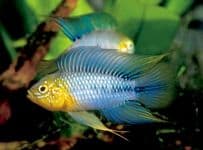
The Apistogramma borelli yellow blue 1 pair is an attractive freshwater fish native to the Amazon River basin in South America. This species is a member of the Apistogramma genus, which is known for its vibrant colors and active behavior. The Apistogramma borelli yellow blue 1 pair features a bright yellow body with blue and black accents, and can reach up to 4 inches in length when fully grown. This species is considered to be a peaceful and timid fish, though they may become territorial around their own kind. When kept in an aquarium, they should be kept in pairs to help reduce aggression and promote natural behaviors. The Apistogramma borelli yellow blue 1 pair is an ideal choice for beginners and experienced aquarists alike, and is sure to add a splash of color to any aquarium.
$100.00
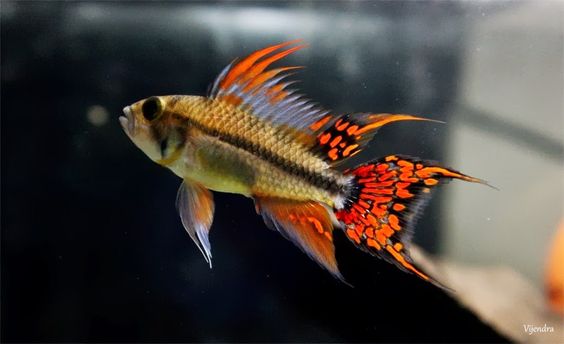
Apistogramma Cacatuoides Double Red is a stunning and unique freshwater fish native to the Amazon River Basin. This fish is a member of the cichlid family and has a vibrant red coloration on its body and fins. It has a deep red head and tail and the body is covered in black and red vertical stripes. This fish is relatively small, reaching an adult size of only 3.5 inches. It is an egg-layer and prefers to live in a densely planted aquarium with plenty of hiding places. This fish is quite hardy and can adapt to a wide range of water parameters and conditions. It is an omnivore and will accept a variety of foods, including frozen and live foods. The Apistogramma Cacatuoides Double Red is a popular choice for aquarium hobbyists due to its unique coloration and peaceful nature.
$40.00
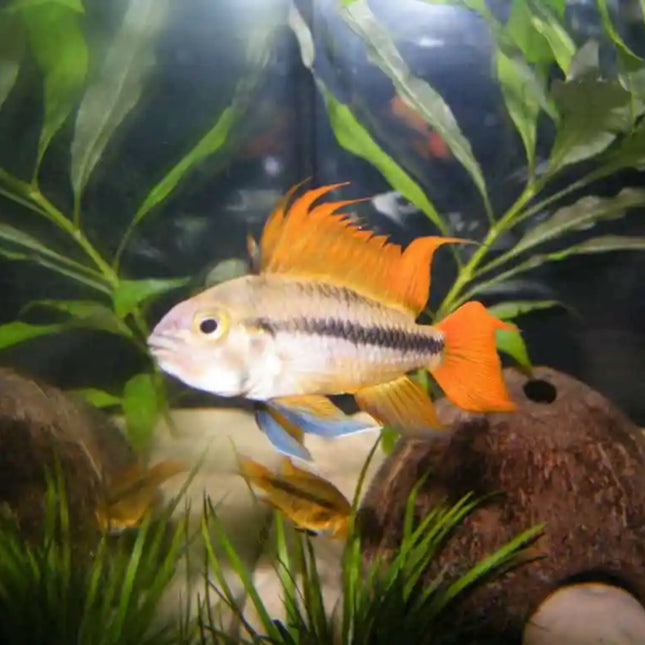
PRICES ARE FOR EACH FISHPlaceholder image from:http://i396.photobucket.com/albums/pp45/BigBruiserAl/DSCF3832.jpg
$20.00
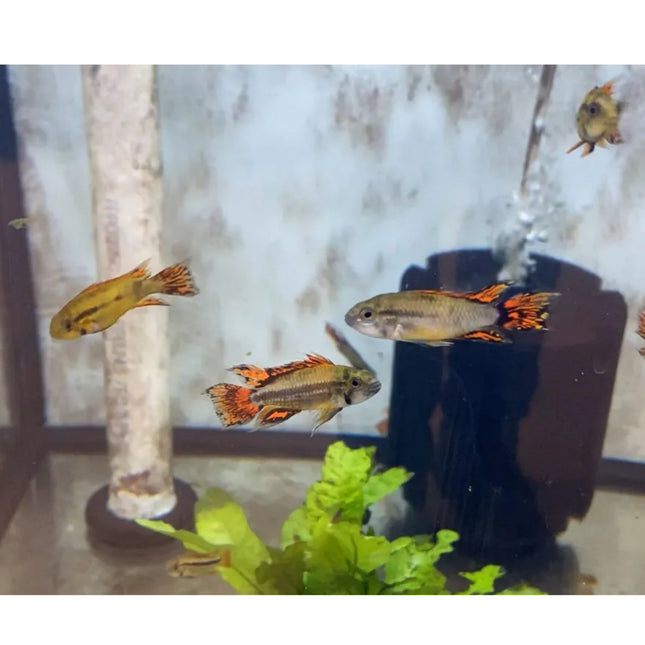
Apistogramma cacatuoides - Cockatoo Dwarf Cichlid Overview: Apistogramma cacatuoides Cockatoo Dwarf Cichlid is a widespread species of cichlid that originated from the tributaries and Amazon river basin of Colombia and Tabatinga in Peru. These days, Apistogramma cacatuoides are very popular with most aquarists worldwide and commonly bred in captivity. Characteristics: The male Apistogramma cacatuoides have an average size of 8 centimeters in length, and their female counterparts are considerably smaller, with a usual size of 5 centimeters. They have an elongated body and have a relatively big mouth with thick lips. The male cockatoo dwarf cichlid has a more vibrant color than the female. They both have a dorsal and caudal fin that has a usual shade of red/orange. The female Apistogramma cacatuoides have normal dull coloration with a clear black line that runs along her flanks. Her background color is light yellow that turns brighter when mating or brood protecting. These fishes have several colorations that form naturally in the wild such as yellow, blue, and red. Feeding: Primarily, Apistogramma cacatuoides are carnivores, and in the wild, the food of their choice are benthic invertebrates. Here are the food that you could offer them Bloodworm Daphnia Artemia Flakes Tank Requirements: The cockatoo dwarf will thrive the most in a planted aquarium. The males are highly territorial, and because of that, it is ideal for keeping them in a group of three (1 male with two females) or on a harem situation (1 male with multiple females). They should have peaceful tankmates like tetras and must be kept on a tank with a capacity of at least 20 gallons. Branches and wood roots are a great addition to your tank since they can provide a space for your fish to hide and play. You can also add some soft and sandy subtrate to achieve a more natural appearance. Water Parameters Temperature: 22 – 29 °C PH level: 5.0 - 6.0 Hardiness: 0 – 268 ppm, depending on the origin There is some South American dwarf cichlid that can tolerate alkaline water. Breeding: Apistogramma cacatuoides lay their eggs on caves, crevices, under a leaf or cavities among the decors. Females are responsible for taking care of the eggs while the male ones guard the territory. Monitor the fish once in a while since the females have a tendency of becoming hyper-aggressive. In that situation, the males should be transferred to a separate tank.
$69.00 $50.00
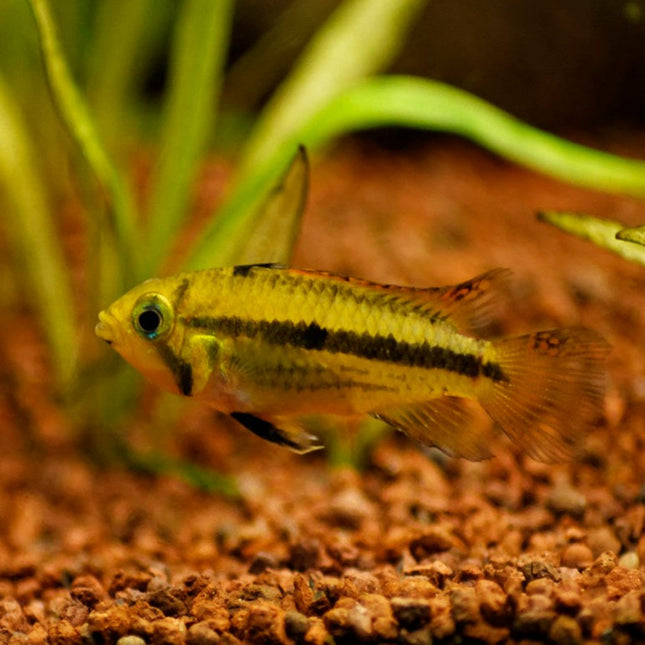
Sold as Pair. (1 pair left)
$100.00
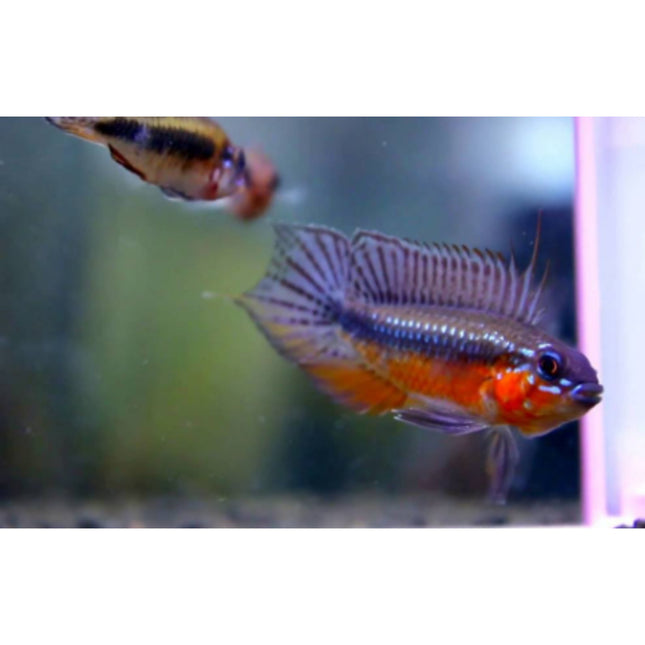
Apistogramma Elizabethae was named in honour of Mrs Elizabeth Cabot Cary Agassiz (1822-1907) the second wife of J.L.R Agasassi. This is one of the rarest and highly priced Apistogramma species and it is more stunning in person. Originally this species lives in tannin based water where there is a lot of fallen leaves and foliage and as a result the fish that you see have very nice and bright colours. Water Parameters These fish prefer a water temperature of around 23-29°C with a pH of 4-7 and a hardness of 18-54ppm. Nano Tanks Australia had the opportunity to bring this species in back in 2019, however due to the price point we were not able to bring it in at this time. Over the course of the last few years the price has gone down as Wild Caught specimens were bred by the Malaysian farms and as a result the price point has gone lower. In 2021 we were given a chance to import this species into Australia, however we understand that although we are not the first shop to bring these to Australia we are pleased to advise that we hold one of the strongest numbers of varieties of Apistogramma in Australia. Image taken from YouTube: https://www.youtube.com/watch?v=0hkQjJHqVPA
$300.00
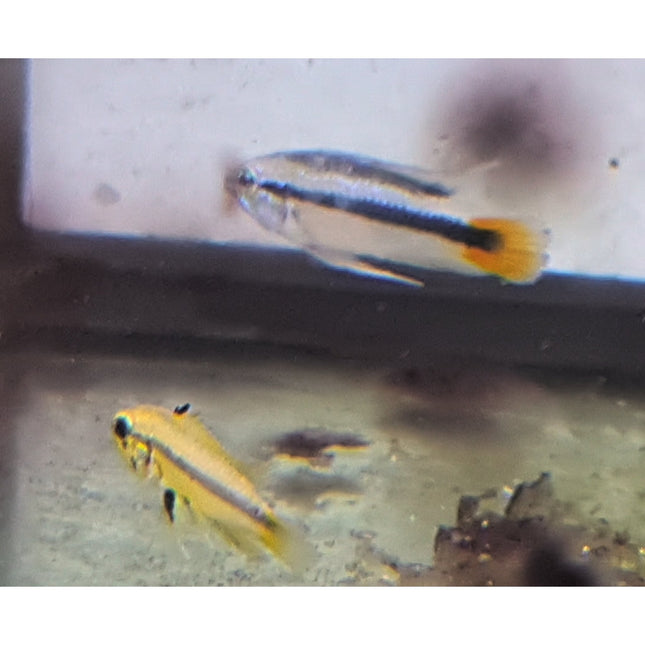
Apistogramma Erythrura Rio Mamore is a small and beautiful cichlid fish species that originates from the Rio Mamore river basin in Bolivia. It has a distinctively bright red coloration with a black and white pattern on its body. Its dorsal and caudal fins are also colored in bright red. This species is also known as the 'Red Dwarf Cichlid' as it typically grows to only reach around 3 inches in length. It is a peaceful fish that prefers to be kept in small groups of 6 or more. It is a great addition to any planted tank and can be kept with other peaceful species.
$75.00
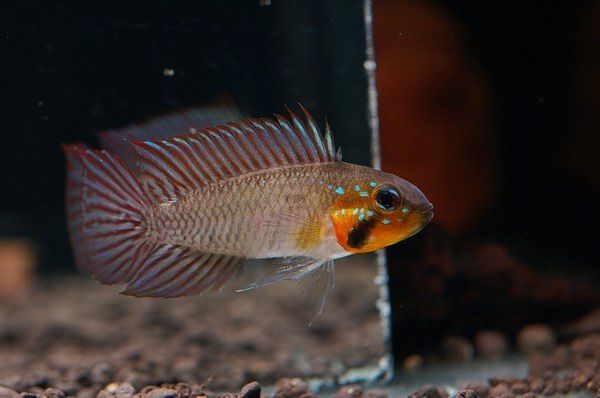
Apistogramma gibbiceps is a species of cichlid fish native to South America. It is a popular aquarium fish due to its striking colors and hardy nature. The body of the fish is a bright yellow-orange color, with a black lateral stripe running along the length of the body and a bright blue dorsal fin. Males are larger and more colorful than females, with a bright yellow head and a blue-black line running down their back. They are an egg-scattering species, and males will defend a territory to protect their eggs and fry. They can be kept in groups and prefer water temperatures of 72-82°F. They are omnivorous, and their diet should consist of a variety of prepared foods, frozen and live foods, and vegetable matter.
$75.00

Apistogramma hoignei is a species of cichlid endemic to the Rio Negro basin in Brazil. It is a small, colorful fish that grows to a maximum length of around 4 centimeters (1.6 inches). Its body is predominantly yellowish-brown or olive with black or dark brown stripes or blotches. The males have a more intense coloration than the females, with a red-orange patch on their forehead and a black and yellow pattern on their body. It is a peaceful, yet territorial species and does best in an aquarium with plenty of hiding places. It is an omnivore and will accept a variety of foods including flakes, frozen and live foods.
$150.00
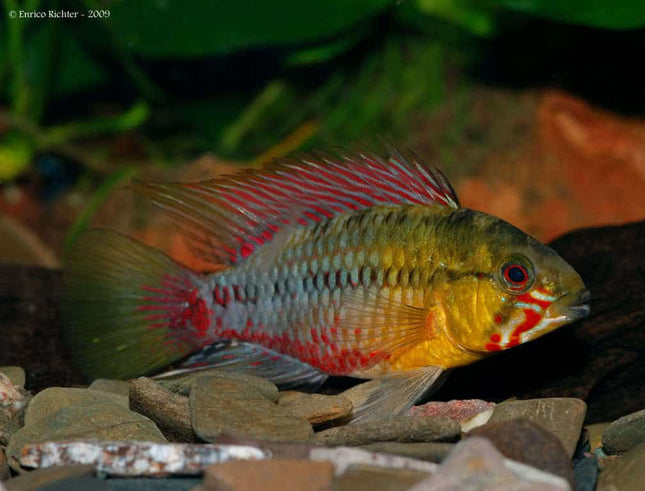
Apistogramma hongsloi red line is a rare and beautiful fish. It has a vibrant red stripe down its body, with a black and yellow speckling pattern on its head and fins. It is a very hardy fish, and can do well in most aquarium settings. This species is a great addition to any community tank, and is a peaceful fish. The price for one of these fish is usually around $15, making it an affordable option for any aquarium hobbyist.
$90.00
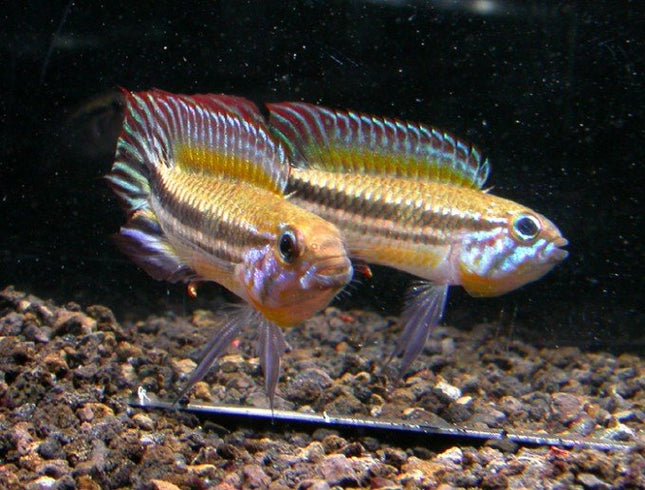
Apistogramma-mendezi is a species of cichlid fish that is native to the Amazon Basin in South America. This colorful fish species is characterized by its brilliant blue and yellow stripes, and its petite size. Apistogramma-mendezi typically grows to be between 2.5 and 3.5 inches in length, and is known to form small schools in the wild. The fish is an omnivore and in the wild will feed on worms, crustaceans, and small insects. In captivity, they should be provided with a varied diet of flakes, pellets, and frozen food. They are also known for being quite territorial, so it is best to keep them in a tank with plenty of hiding places and plants to provide shelter.
$100.00
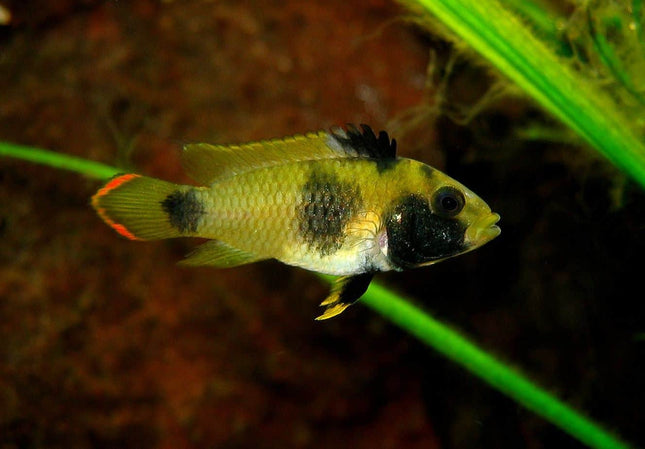
Apistogramma-nijsseni is a species of small, colorful cichlid fish native to South America. It grows up to three inches in length and has a unique, bright yellow and black pattern. The fins are long and pointed, and the males have an extended dorsal fin. These fish are very active and social, and form large schools when in the wild. They are also very territorial and will defend their territory against other fish. They prefer soft, acidic water, and need plenty of hiding places, such as caves and driftwood, to feel secure. Apistogramma-nijsseni is a great choice for the avid aquarist looking for a bright, active fish.
$150.00
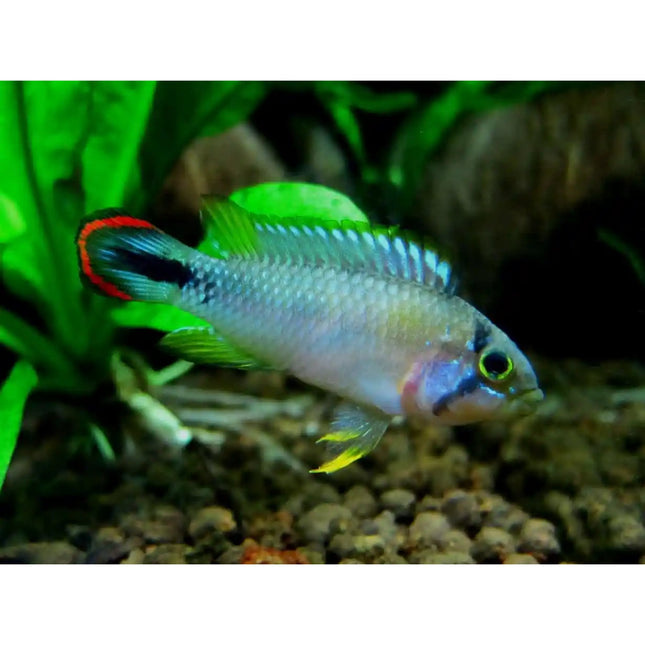
Distribution Described from the Río Ucayali drainage in Genaro/Jenaro Herrera District, Requena Province, Loreto Region, northern Peru and also known from the Río Tahuayo further north, after the Ucayali’s confluence with the Río Maranón. A variant from the Río Tamshiyacu, which lies more-or-less adjacent to the Tahuayo, may or may not represent the same species (see ‘notes’). Habitat Tends to inhabit slower-moving tributaries, backwaters and creeks in areas where fallen leaf litter collects. Maximum Standard Length Male: 7.5 cm Female: 5.5 cm Water Conditions Temperature: 22 – 29 °C pH: 4.0 – 6.5 Hardness: 0 – 90 ppm Reference https://www.seriouslyfish.com/species/apistogramma-panduro/
$80.00
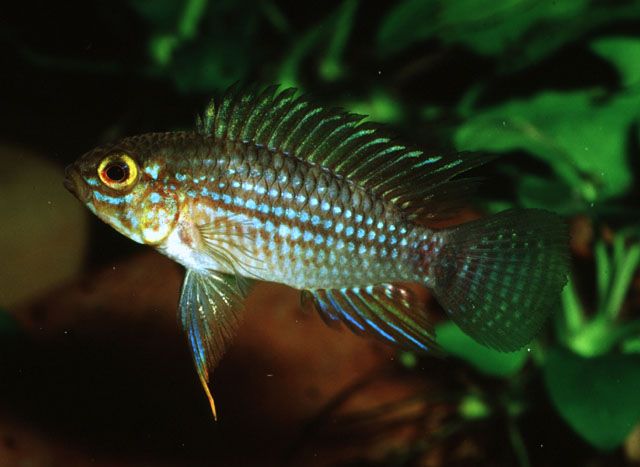
Apistogramma Piauiensis is a species of freshwater fish from the family of cichlids. It is a small fish, up to 2.8 inches (7 cm) in length, with a yellowish-green body and a black stripe running along its sides. The males have a bright blue coloration on their cheeks and gill covers. This species is found in the upper coastal streams of the Parnaiba River in northeastern Brazil, and is one of the most spectacularly colored of all Apistogramma species. Apistogramma Piauiensis is an omnivorous fish that feeds on small invertebrates, insect larvae and plant matter. It is an excellent choice for a community tank, and is known to be very peaceful and display beautiful coloration.
$60.00
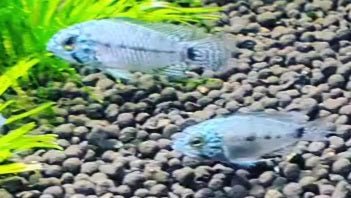
Apistogramma sp Neon Blue Head is a species of cichlid fish native to South America. They are a small fish, typically reaching a maximum size of 2.5 inches, and have a unique body shape that is high and pointed at the back and flat at the front. The males are particularly striking, with a vibrant electric blue head and body that is highlighted with yellow stripes and spots, and a black tail. The females are a more muted yellow with a brown head and a yellow to orange tail. The fish prefer acidic water, and should be kept in an aquarium with plenty of hiding places and a sandy substrate. They are a peaceful species that can be kept in groups, but they are somewhat territorial and should be provided with plenty of space.
$45.00
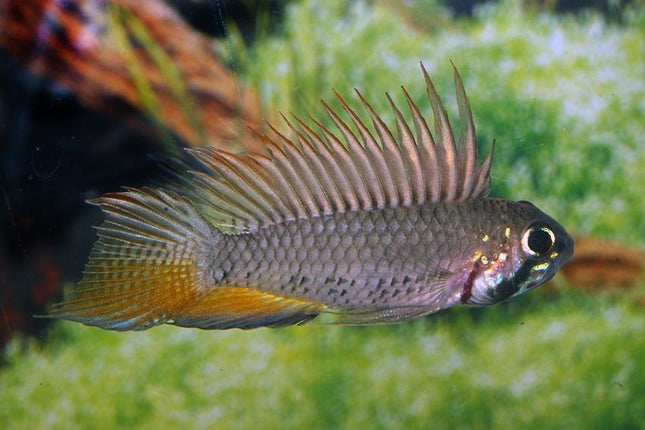
Apistogramma-sp-megaptera-1-pair is a beautiful species of dwarf cichlid found in the Amazon basin in Peru, Brazil, and Ecuador. This fish has a striking yellow, purple, and black pattern on its body and fins. It grows to a maximum size of 4 inches, making it an ideal choice for aquariums. This species is quite peaceful, and can be kept in a community aquarium with other non-aggressive fish like rasboras, tetras, and danios. It prefers a slightly acidic pH between 6.0-7.0, and soft to moderately hard water with temperatures between 72-82F. Apistogramma-sp-megaptera-1-pair is an egg layer, and in an aquarium setting the female will lay her eggs on the substrate or on the leaves of plants. This species is an excellent choice for experienced aquarists looking to add a unique and beautiful fish to their tank.
$200.00
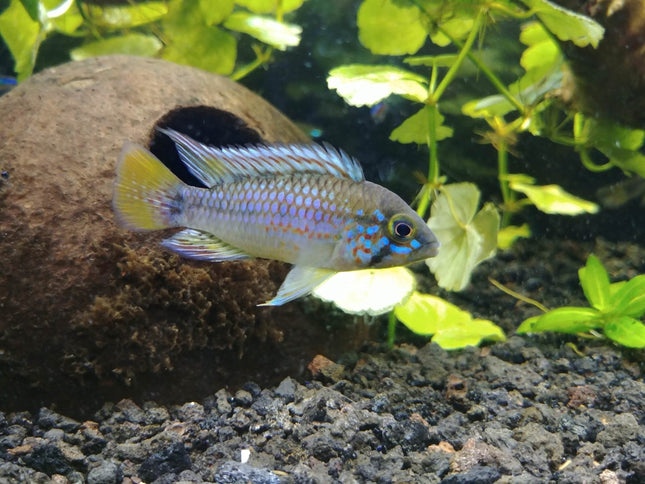
Apistogramma-sp-pebas is a species of small, freshwater fish native to South America. It is a member of the cichlid family and has a striking color pattern of yellow, orange, and black. The fish typically grows to a size of 2 to 3 inches and is an active swimmer. Apistogramma-sp-pebas is an omnivore, feeding on a variety of invertebrates and plant-based foods. It is an egg-layer, and the eggs are laid in a cave or crevice. The fish is well-suited to aquarium environments and is popular among hobbyists.
$75.00
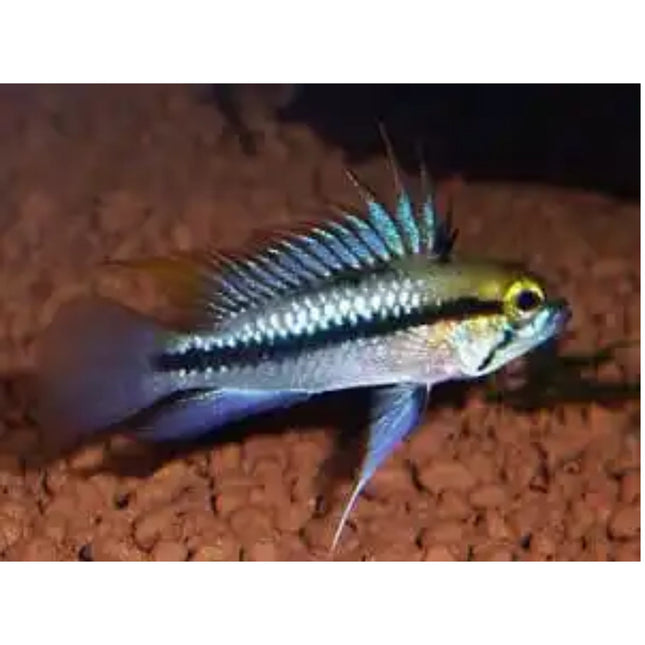
Apistogramma trifasciata pairs are a species of dwarf cichlid found in South America. They are a popular choice for aquarium owners due to their striking coloration and ease of care. They are a pair-bonding species, meaning that they form strong social bonds with one another. Males are typically larger and more brightly colored than females, with bright yellow bodies, dark vertical stripes, and red markings on the head and fins. Females are typically more drably colored than males, but they can still display a variety of colors. They prefer soft, acidic water and do well in planted aquariums with plenty of rockwork and hiding places. Apistogramma trifasciata pairs are peaceful, but may become aggressive towards other fish if they feel threatened. They are also known to be territorial, so it is important to provide plenty of space for them to swim and hide.
$40.00
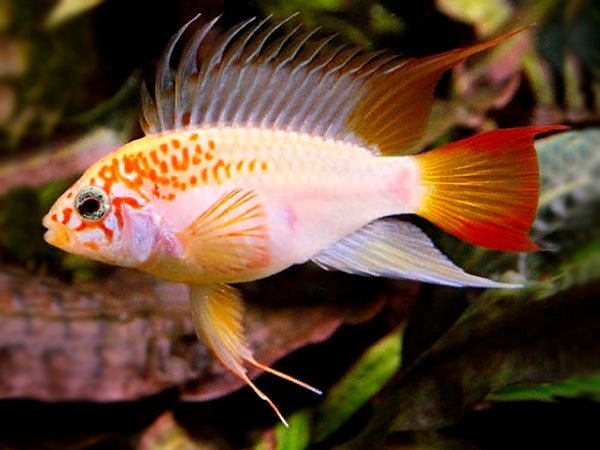
The Apistogramma viejita macmasteri gold is a stunning and vibrant fish species native to South America. This species has a bright yellow-gold body, with bright shining blue-green fins. The head of this fish is a darker brown color, with a bluish-black stripe running from the forehead to the lower part of the body. Other features include a black stripe that runs from the head to the tail, and a light yellow-gold stripe that runs along the body. This fish is an active, bold and hardy species that does well in an aquarium environment. It is an ideal fish for a community tank, as it is peaceful and will not harm other fish. It is also an excellent addition to larger tanks with other Apistogramma species.
$65.00
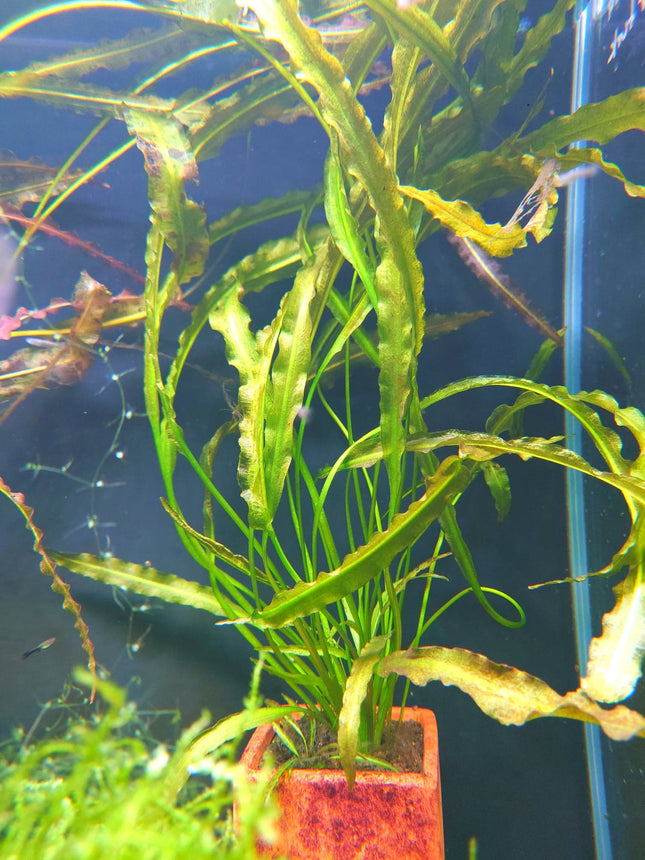
Aponogeton crispis is a small aquatic plant native to Sri Lanka and popular in aquariums. It has a rosette of stiff, crisp leaves that are light green to dark green in color. The leaves grow to a maximum size of around 6 inches in length and 3 inches in width. Its flower stalk grows to a height of about 10 inches, bearing small white flowers. Aponogeton crispis is a low maintenance plant that does not require extra fertilization or supplemental lighting in order to thrive. It is a great choice for an aquarium as it will not take up too much space and is relatively hardy.
$20.00

Aponogeton crispus Red is a striking aquatic plant with bright, deep burgundy leaves. It is an easy-to-care-for plant that is great for beginners. It has a rounded shape with wavy leaves that are slightly pointed at the ends. This plant prefers a low to moderate light level and soft to medium hard water. It is best to keep the water temperature between 68-80°F (20-27°C). This plant can be propagated with cuttings or runners and is great for aquariums and ponds. It is a slow-growing, low maintenance plant and is a great addition to any water garden.
$35.00
If you need help with your tank this is the service for you
$0.00
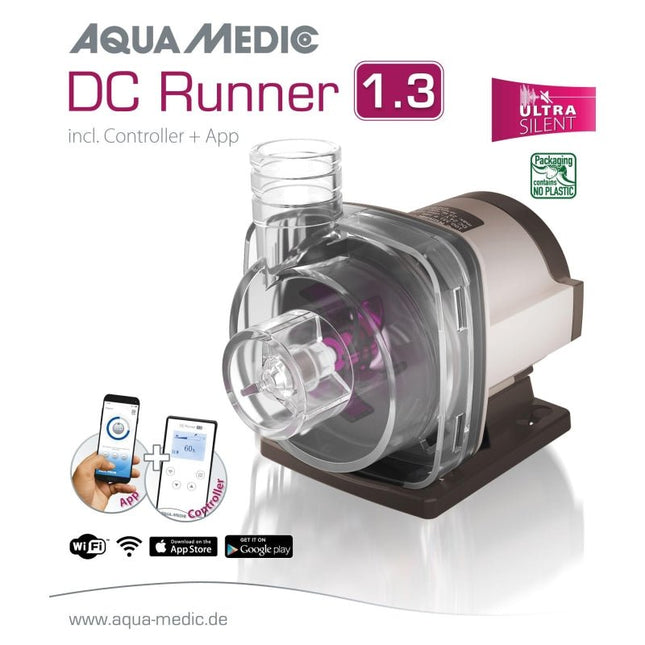
ULTRA SILENT due to Optimized Control Electronics. Circulation pump suitable for use in salt or freshwater aquaria. Includes controller for adjusting the water output. 0–10V-connection for external control. Rugged pump housing. Power-saving D/C motor 24 Volt. High efficiency. Polished ceramic shaft and bearings for quiet operation and low maintenance. Submerged and non-submerged use is possible. Including pre-filter basket. DC Runner 1.2: Output 8 step adjustable up to 1200 L/H. Maximum Head 1.5mtrs. Max Power 12w. L125 x W60 x H85mm. Hose fitting suction side 25mm. Hose fitting pressure side 20mm. 2 years warranty.
$399.00

ULTRA SILENT due to Optimized Control Electronics. Circulation pump suitable for use in salt or freshwater aquaria. Includes controller for adjusting the water output. 0–10V-connection for external control. Rugged pump housing. Power-saving D/C motor 24 Volt. High efficiency. Polished ceramic shaft and bearings for quiet operation and low maintenance. Submerged and non-submerged use is possible. Including pre-filter basket and stepped hose fittings. DC Runner 2.2: Output 8 step adjustable up to 2000 L/H. Maximum Head 2.20 mtrs. Max Power 20w. L135 x W67 x H67mm. Stepped hose fitting suction side 25mm/20mm. Stepped hose fitting pressure side 25mm/20mm. 2 year warranty.
$479.00
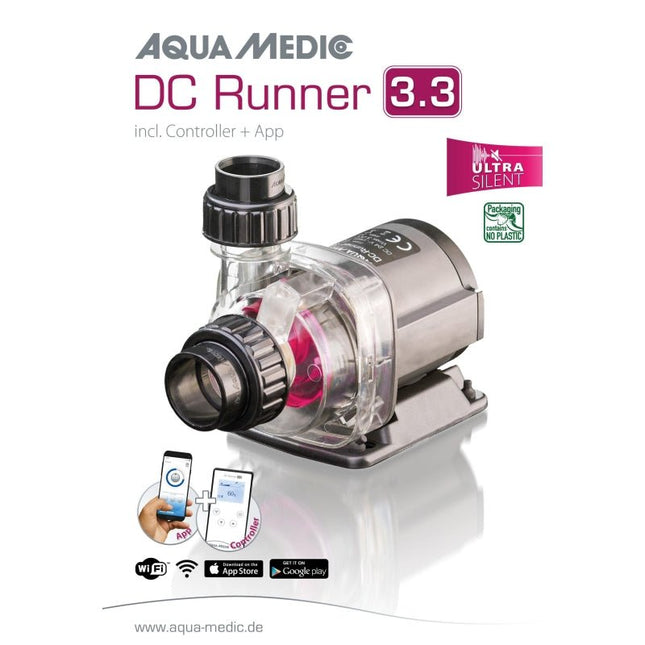
ULTRA SILENT due to Optimized Control Electronics. Circulation pump suitable for use in salt or freshwater aquaria. Includes controller for adjusting the water output. 0–10V-connection for external control. Rugged pump housing. Power-saving D/C motor 24 Volt. High efficiency. Polished ceramic shaft and bearings for quiet operation and low maintenance. Submerged and non-submerged use is possible. Including pre-filter basket and stepped hose fittings. DC Runner 3.2: Output 8 step adjustable up to 3000 L/H. Maximum Head 2.70 mtrs. Max Power 25w. L200 x W90 x H120mm. Stepped hose fitting suction side 32mm/25mm. Stepped hose fitting pressure side 25mm/20mm. 2 year warranty.
$529.00
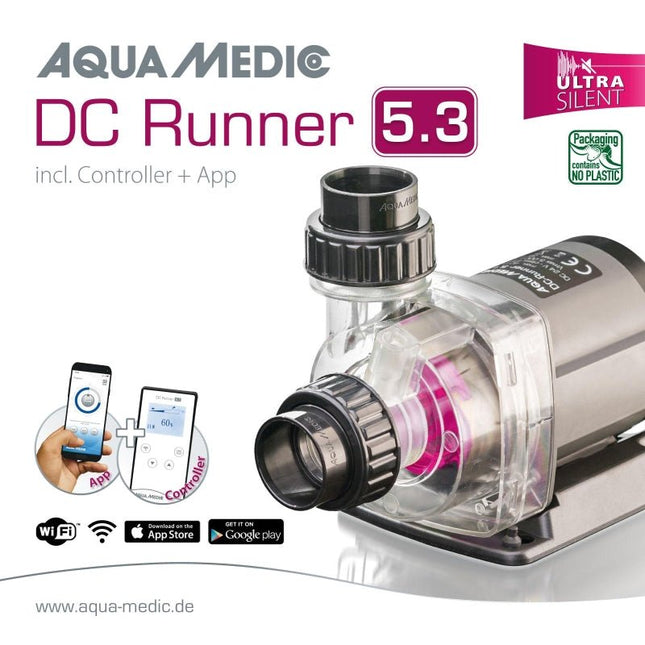
ULTRA SILENT due to Optimized Control Electronics. Circulation pump suitable for use in salt or freshwater aquaria. Includes controller for adjusting the water output. 0–10V-connection for external control. Rugged pump housing. Power-saving D/C motor 24 Volt. High efficiency. Polished ceramic shaft and bearings for quiet operation and low maintenance. Submerged and non-submerged use is possible. Including pre-filter basket and stepped hose fittings. DC Runner 5.3: Output 8 step adjustable up to 5000 L/H. Maximum Head 3.50 mtrs. Max Power 40w. L190 x W105 x H130mm. Stepped hose fitting suction side 32mm/25mm. Stepped hose fitting pressure side 32mm/25mm. 2 year warranty.
$499.00

ULTRA SILENT due to Optimized Control Electronics. Circulation pump suitable for use in salt or freshwater aquaria. Includes controller for adjusting the water output. 0–10V-connection for external control. Rugged pump housing. Power-saving D/C motor 24 Volt. High efficiency. Polished ceramic shaft and bearings for quiet operation and low maintenance. Submerged and non-submerged use is possible. Including stepped hose fittings. DC Runner 9.3: Output 8 step adjustable up to 9000 L/H. Maximum Head 4.80 mtrs. Max Power 65w. L200 x W105 x H180mm. Stepped hose fitting suction side 40mm/32mm. Stepped hose fitting pressure side 40mm/32mm. 2 year warranty.
$779.00
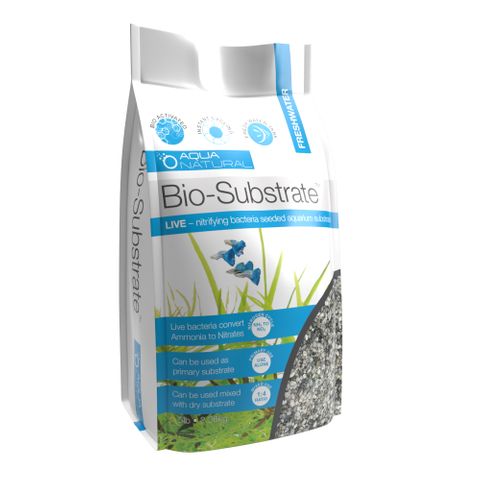
Aqua Natural Substrates All Aqua Natural gravel or substrates are 100% natural, sustainably sourced, triple washed and kiln dried. Our meticulously graded gravels and sands are the perfect natural substrates for any aquarium including planted tanks. Our high quality products create natural beauty combined with large surface areas for beneficial bacteria colonies and easy cleaning. Nitrifying Bacteria Pack contains bio activated live nitrifying bacteria to either use as a primary substrate or mix with substrate for a healthy aquarium. Contains a patented blend of live nitrosomas and nitrobacter bacteria which break down and convert harmful ammonia, into nitrates. Directions for use: PRIMARY (not mixed with Dry Substrate) Usage Calculator: Use 1lb (450g) of Bio-Substrate for every 1 gallons (3.8 litres) of water. • DO NOT rinse before use. • Spread substrate and fill with water slowly. Avoid stirring up the substrate. • Once the tank is filled, start your filter. Any cloudy appearance should clear over time. MIXED (mixed with Dry Substrate) Usage Calculator: Use 1lb (450g) of mixed LIVE Bio-Substrate and DRY Substrate for every 1 gallons (3.8 litres) of water. Mixing ratio is 1:4 (1 LIVE to 4 DRY). • DO NOT rinse before use. • Mix Bio-Substrate and Dry Substrate thoroughly. • Now spread mixed substrate and fill with water slowly. Avoid stirring up the substrate. • Once the tank is filled, start your filter. • Any cloudy appearance should clear over time. LIVE nitrosomas and nitrobacter bacteria are harmless to marine life. Use with any corresponding Dry Aqua Natural
$14.00
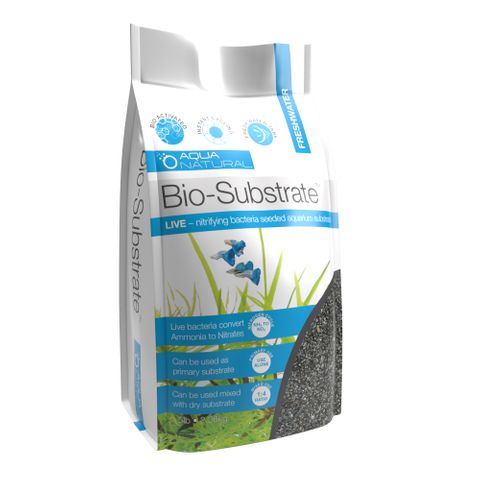
Aqua Natural Substrates All Aqua Natural gravel or substrates are 100% natural, sustainably sourced, triple washed and kiln dried. Our meticulously graded gravels and sands are the perfect natural substrates for any aquarium including planted tanks. Our high quality products create natural beauty combined with large surface areas for beneficial bacteria colonies and easy cleaning. Nitrifying Bacteria Pack contains bio activated live nitrifying bacteria to either use as a primary substrate or mix with substrate for a healthy aquarium. Contains a patented blend of live nitrosomas and nitrobacter bacteria which break down and convert harmful ammonia, into nitrates. Directions for use: PRIMARY (not mixed with Dry Substrate) Usage Calculator: Use 1lb (450g) of Bio-Substrate for every 1 gallons (3.8 litres) of water. • DO NOT rinse before use. • Spread substrate and fill with water slowly. Avoid stirring up the substrate. • Once the tank is filled, start your filter. Any cloudy appearance should clear over time. MIXED (mixed with Dry Substrate) Usage Calculator: Use 1lb (450g) of mixed LIVE Bio-Substrate and DRY Substrate for every 1 gallons (3.8 litres) of water. Mixing ratio is 1:4 (1 LIVE to 4 DRY). • DO NOT rinse before use. • Mix Bio-Substrate and Dry Substrate thoroughly. • Now spread mixed substrate and fill with water slowly. Avoid stirring up the substrate. • Once the tank is filled, start your filter. • Any cloudy appearance should clear over time. LIVE nitrosomas and nitrobacter bacteria are harmless to marine life. Use with any corresponding Dry Aqua Natural
$14.00
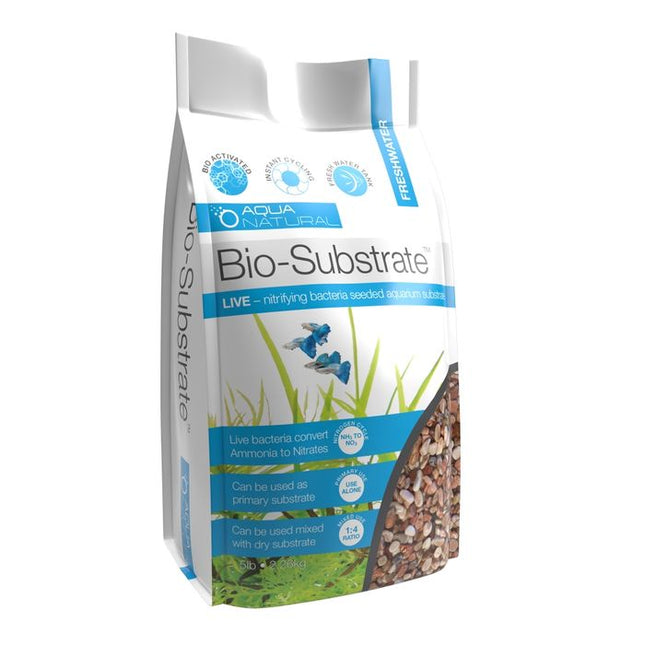
Aqua Natural Substrates All Aqua Natural gravel or substrates are 100% natural, sustainably sourced, triple washed and kiln dried. Our meticulously graded gravels and sands are the perfect natural substrates for any aquarium including planted tanks. Our high quality products create natural beauty combined with large surface areas for beneficial bacteria colonies and easy cleaning. Nitrifying Bacteria Pack contains bio activated live nitrifying bacteria to either use as a primary substrate or mix with substrate for a healthy aquarium. Contains a patented blend of live nitrosomas and nitrobacter bacteria which break down and convert harmful ammonia, into nitrates. Directions for use: PRIMARY (not mixed with Dry Substrate) Usage Calculator: Use 1lb (450g) of Bio-Substrate for every 1 gallons (3.8 litres) of water. • DO NOT rinse before use. • Spread substrate and fill with water slowly. Avoid stirring up the substrate. • Once the tank is filled, start your filter. Any cloudy appearance should clear over time. MIXED (mixed with Dry Substrate) Usage Calculator: Use 1lb (450g) of mixed LIVE Bio-Substrate and DRY Substrate for every 1 gallons (3.8 litres) of water. Mixing ratio is 1:4 (1 LIVE to 4 DRY). • DO NOT rinse before use. • Mix Bio-Substrate and Dry Substrate thoroughly. • Now spread mixed substrate and fill with water slowly. Avoid stirring up the substrate. • Once the tank is filled, start your filter. • Any cloudy appearance should clear over time. LIVE nitrosomas and nitrobacter bacteria are harmless to marine life. Use with any corresponding Dry Aqua Natural
$14.00
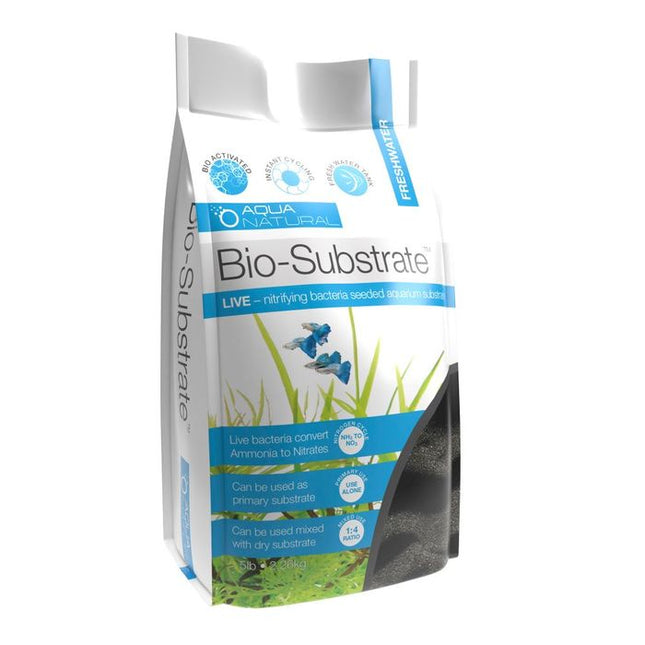
Aqua Natural Substrates All Aqua Natural gravel or substrates are 100% natural, sustainably sourced, triple washed and kiln dried. Our meticulously graded gravels and sands are the perfect natural substrates for any aquarium including planted tanks. Our high quality products create natural beauty combined with large surface areas for beneficial bacteria colonies and easy cleaning. Nitrifying Bacteria Pack contains bio activated live nitrifying bacteria to either use as a primary substrate or mix with substrate for a healthy aquarium. Contains a patented blend of live nitrosomas and nitrobacter bacteria which break down and convert harmful ammonia, into nitrates. Directions for use: PRIMARY (not mixed with Dry Substrate) Usage Calculator: Use 1lb (450g) of Bio-Substrate for every 1 gallons (3.8 litres) of water. • DO NOT rinse before use. • Spread substrate and fill with water slowly. Avoid stirring up the substrate. • Once the tank is filled, start your filter. Any cloudy appearance should clear over time. MIXED (mixed with Dry Substrate) Usage Calculator: Use 1lb (450g) of mixed LIVE Bio-Substrate and DRY Substrate for every 1 gallons (3.8 litres) of water. Mixing ratio is 1:4 (1 LIVE to 4 DRY). • DO NOT rinse before use. • Mix Bio-Substrate and Dry Substrate thoroughly. • Now spread mixed substrate and fill with water slowly. Avoid stirring up the substrate. • Once the tank is filled, start your filter. • Any cloudy appearance should clear over time. LIVE nitrosomas and nitrobacter bacteria are harmless to marine life. Use with any corresponding Dry Aqua Natural
$19.00

Aqua Natural Substrates All Aqua Natural gravel or substrates are 100% natural, sustainably sourced, triple washed and kiln dried. Our meticulously graded gravels and sands are the perfect natural substrates for any aquarium including planted tanks. Our high quality products create natural beauty combined with large surface areas for beneficial bacteria colonies and easy cleaning. Nitrifying Bacteria Pack contains bio activated live nitrifying bacteria to either use as a primary substrate or mix with substrate for a healthy aquarium. Contains a patented blend of live nitrosomas and nitrobacter bacteria which break down and convert harmful ammonia, into nitrates. Directions for use: PRIMARY (not mixed with Dry Substrate) Usage Calculator: Use 1lb (450g) of Bio-Substrate for every 1 gallons (3.8 litres) of water. • DO NOT rinse before use. • Spread substrate and fill with water slowly. Avoid stirring up the substrate. • Once the tank is filled, start your filter. Any cloudy appearance should clear over time. MIXED (mixed with Dry Substrate) Usage Calculator: Use 1lb (450g) of mixed LIVE Bio-Substrate and DRY Substrate for every 1 gallons (3.8 litres) of water. Mixing ratio is 1:4 (1 LIVE to 4 DRY). • DO NOT rinse before use. • Mix Bio-Substrate and Dry Substrate thoroughly. • Now spread mixed substrate and fill with water slowly. Avoid stirring up the substrate. • Once the tank is filled, start your filter. • Any cloudy appearance should clear over time. LIVE nitrosomas and nitrobacter bacteria are harmless to marine life. Use with any corresponding Dry Aqua Natural
$14.00 - $48.00
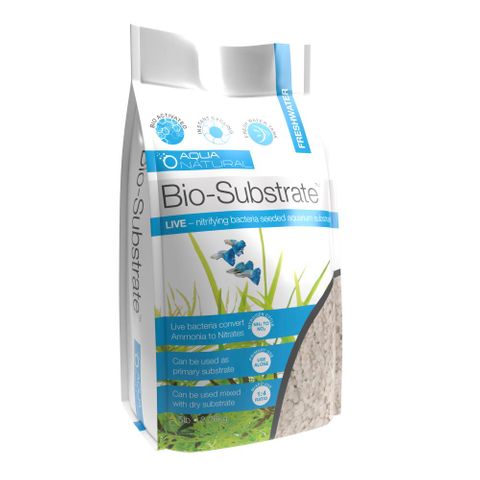
Aqua Natural Substrates All Aqua Natural gravel or substrates are 100% natural, sustainably sourced, triple washed and kiln dried. Our meticulously graded gravels and sands are the perfect natural substrates for any aquarium including planted tanks. Our high quality products create natural beauty combined with large surface areas for beneficial bacteria colonies and easy cleaning. Nitrifying Bacteria Pack contains bio activated live nitrifying bacteria to either use as a primary substrate or mix with substrate for a healthy aquarium. Contains a patented blend of live nitrosomas and nitrobacter bacteria which break down and convert harmful ammonia, into nitrates. Directions for use: PRIMARY (not mixed with Dry Substrate) Usage Calculator: Use 1lb (450g) of Bio-Substrate for every 1 gallons (3.8 litres) of water. • DO NOT rinse before use. • Spread substrate and fill with water slowly. Avoid stirring up the substrate. • Once the tank is filled, start your filter. Any cloudy appearance should clear over time. MIXED (mixed with Dry Substrate) Usage Calculator: Use 1lb (450g) of mixed LIVE Bio-Substrate and DRY Substrate for every 1 gallons (3.8 litres) of water. Mixing ratio is 1:4 (1 LIVE to 4 DRY). • DO NOT rinse before use. • Mix Bio-Substrate and Dry Substrate thoroughly. • Now spread mixed substrate and fill with water slowly. Avoid stirring up the substrate. • Once the tank is filled, start your filter. • Any cloudy appearance should clear over time. LIVE nitrosomas and nitrobacter bacteria are harmless to marine life. Use with any corresponding Dry Aqua Natural
$14.00
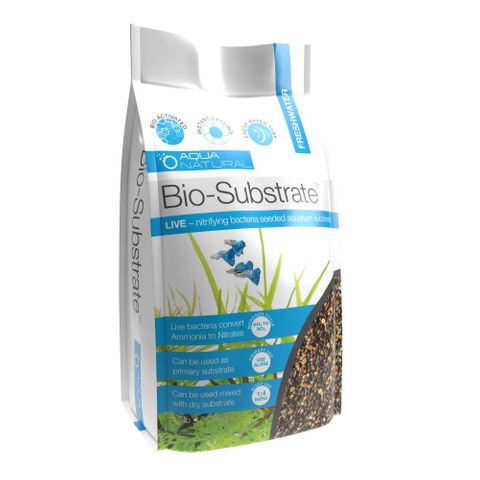
Aqua Natural Substrates All Aqua Natural gravel or substrates are 100% natural, sustainably sourced, triple washed and kiln dried. Our meticulously graded gravels and sands are the perfect natural substrates for any aquarium including planted tanks. Our high quality products create natural beauty combined with large surface areas for beneficial bacteria colonies and easy cleaning. Nitrifying Bacteria Pack contains bio activated live nitrifying bacteria to either use as a primary substrate or mix with substrate for a healthy aquarium. Contains a patented blend of live nitrosomas and nitrobacter bacteria which break down and convert harmful ammonia, into nitrates. Directions for use: PRIMARY (not mixed with Dry Substrate) Usage Calculator: Use 1lb (450g) of Bio-Substrate for every 1 gallons (3.8 litres) of water. • DO NOT rinse before use. • Spread substrate and fill with water slowly. Avoid stirring up the substrate. • Once the tank is filled, start your filter. Any cloudy appearance should clear over time. MIXED (mixed with Dry Substrate) Usage Calculator: Use 1lb (450g) of mixed LIVE Bio-Substrate and DRY Substrate for every 1 gallons (3.8 litres) of water. Mixing ratio is 1:4 (1 LIVE to 4 DRY). • DO NOT rinse before use. • Mix Bio-Substrate and Dry Substrate thoroughly. • Now spread mixed substrate and fill with water slowly. Avoid stirring up the substrate. • Once the tank is filled, start your filter. • Any cloudy appearance should clear over time. LIVE nitrosomas and nitrobacter bacteria are harmless to marine life. Use with any corresponding Dry Aqua Natural
$14.00
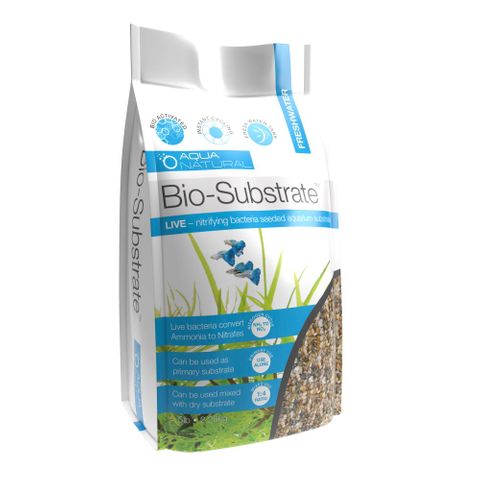
Aqua Natural Substrates All Aqua Natural gravel or substrates are 100% natural, sustainably sourced, triple washed and kiln dried. Our meticulously graded gravels and sands are the perfect natural substrates for any aquarium including planted tanks. Our high quality products create natural beauty combined with large surface areas for beneficial bacteria colonies and easy cleaning. Nitrifying Bacteria Pack contains bio activated live nitrifying bacteria to either use as a primary substrate or mix with substrate for a healthy aquarium. Contains a patented blend of live nitrosomas and nitrobacter bacteria which break down and convert harmful ammonia, into nitrates. Directions for use: PRIMARY (not mixed with Dry Substrate) Usage Calculator: Use 1lb (450g) of Bio-Substrate for every 1 gallons (3.8 litres) of water. • DO NOT rinse before use. • Spread substrate and fill with water slowly. Avoid stirring up the substrate. • Once the tank is filled, start your filter. Any cloudy appearance should clear over time. MIXED (mixed with Dry Substrate) Usage Calculator: Use 1lb (450g) of mixed LIVE Bio-Substrate and DRY Substrate for every 1 gallons (3.8 litres) of water. Mixing ratio is 1:4 (1 LIVE to 4 DRY). • DO NOT rinse before use. • Mix Bio-Substrate and Dry Substrate thoroughly. • Now spread mixed substrate and fill with water slowly. Avoid stirring up the substrate. • Once the tank is filled, start your filter. • Any cloudy appearance should clear over time. LIVE nitrosomas and nitrobacter bacteria are harmless to marine life. Use with any corresponding Dry Aqua Natural
$14.00
You have seen 108 out of 1934 products